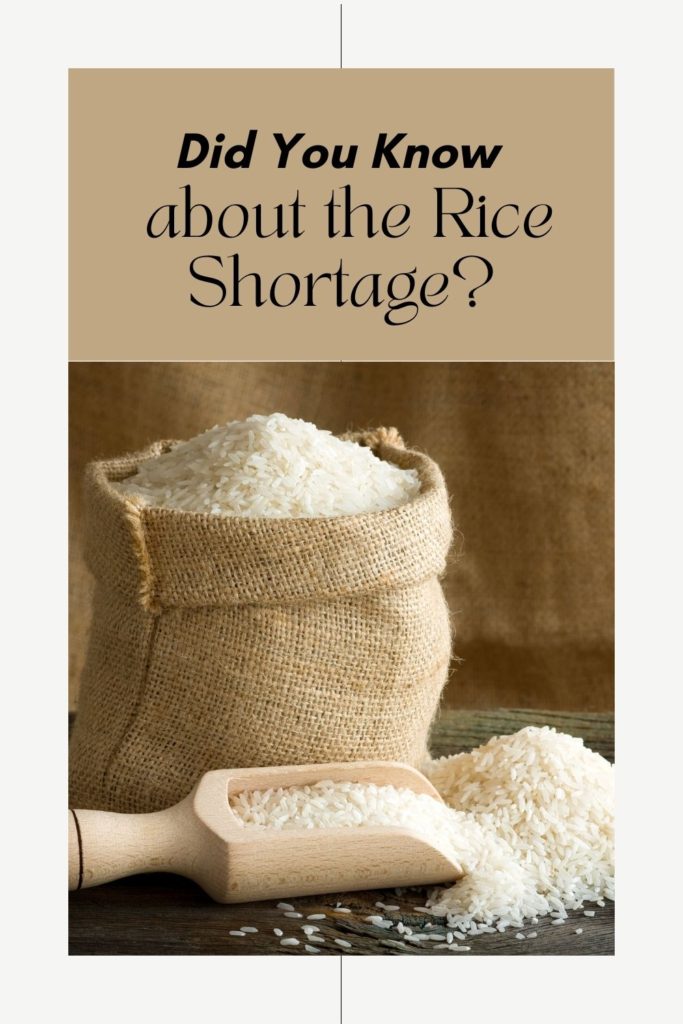Written by Bernie Carr
With this ongoing shortages going on with eggs, wheat, potato and others, I was surprised to hear about yet another shortage.
Did you know about the rice shortage? I came across a report that the world is facing one. There is currently a deficit in the amount of rice being produced, and rice prices are expected to remain high until 2024.
Why is there a rice shortage?
According to a report by Fitch Solutions, the global production of rice has been dropping and the industry is expected to log its largest shortfall between supply and demand in 20 years. This year’s production of rice is set to face the biggest global shortage in decades.
Analysts blamed some major events on the short supply of rice, such as the ongoing Russian invasion of Ukraine, which drives up demand for rice. Ukraine, a major global exporter of wheat and barley, has had a hard time exporting its grains globally due to the Russian-led war.
Heavy monsoon rains and floods also affected rice production in China and Pakistan, two major rice-producing countries.
Source: International Business Times
Also, we have seen reports that European rice-producing countries such as France and Germany that produce the most rice have been hit by the worst drought in 20 years. Even the U.S. and Canada, also rice producers have reported a lower production, contributing to the shortage.
Who is affected by the rice shortage?
About 3.5 billion people worldwide depend on rice as a staple in their diet. The countries that are most impacted are the ones that consume the most rice include Japan, China, India, Philippines, Bangladesh, Vietnam, Indonesia, Thailand, Burma, and Brazil.
Of course if you consume rice in your own household, you’d be affected as well.
What can you to prepare for a rice shortage?
As with other shortages, all you can do is buy while there is adequate supply. I have stored rice for long term before and it is super easy: just use oxygen absorbers and Mylar bags. This system is proven to work, as described when I opened my storage of four year old rice.
Another way I have stored rice is by using a food sealer which has come down in price in recent years.
Make sure you label your stored rice with the contents and date you stored it.
Don’t forget to rotate your supply by using the oldest stash.
Another option is to try rice substitutes, which brings us to the next topic.
Alternatives to rice
Some alternatives to rice include:
- barley
- quinoa
- couscous
- bulgur
- farro
- potatoes
- cassava
- corn
If you like rice as I do, you’ll have to try various substitutes to see if you can get used to them before purchasing a large supply. There is no point in stockpiling foods that you will never eat.
Hopefully the rice shortage won’t last.
Are you concerned about the rice shortage? Please feel free to share in the comments.
If you found this article interesting or helpful, please consider helping us out (without costing you anything)! We are an affiliate of Amazon.com, which means we received a small commission if you click through one of our Amazon links when you shop, at totally no cost to you. This helps keep the lights on at the blog. Thanks!
About the author
Bernie Carr is the founder of Apartment Prepper. She has written several books including the best-selling Prepper’s Pocket Guide, Jake and Miller’s Big Adventure, The Penny-Pinching Prepper and How to Prepare for Most Emergencies on a $50 a Month Budget. Bernie’s latest e-book, FRUGAL DIY has just been released on Amazon. Her work appears in sites such as the Allstate Blog and Clark.com, as well as print magazines such as Backwoods Survival Guide and Prepper Survival Guide. She has been featured in national publications such as Fox Business and Popular Mechanics. Learn more about Bernie here.
FB: https://www.facebook.com/apartmentprepper
Instagram: https://www.instagram.com/apartmentpreppers/
Twitter: https://twitter.com/AptPrepper
YouTube: https://www.youtube.com/channel/UC7vOtdbo-wiBeBxD6puCr1Q
Pinterest: https://www.pinterest.com/aptprepper/



Be aware that high levels of inorganic arsenic can be found in rice.
https://duckduckgo.com/?q=arsenic+in+rice
White tends to have less than brown.
Basmati and Jasmine tend to have less than other varieties.
California rice tends to have less than Texas and Louisiana.
Rice from India, Nepal and Pakistan (Himalayas) tend to have less than rice from the U.S.
Rinsing rice prior to cooking can reduce arsenic up to 28%.
Cooking rice with 6 cups of water per cup of rice, then draining the water can reduce arsenic even further.
Other grains like quinoa have lower arsenic levels.
Hi James, That is a good point – arsenic in rice is something to be aware of. Thanks for pointing that out! I appreciate your comment.